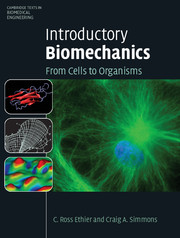Book contents
- Frontmatter
- Contents
- About the cover
- Preface
- 1 Introduction
- 2 Cellular biomechanics
- 3 Hemodynamics
- 4 The circulatory system
- 5 The interstitium
- 6 Ocular biomechanics
- 7 The respiratory system
- 8 Muscles and movement
- 9 Skeletal biomechanics
- 10 Terrestrial locomotion
- Appendix: The electrocardiogram
- Index
- Plate section
- References
8 - Muscles and movement
Published online by Cambridge University Press: 05 June 2012
- Frontmatter
- Contents
- About the cover
- Preface
- 1 Introduction
- 2 Cellular biomechanics
- 3 Hemodynamics
- 4 The circulatory system
- 5 The interstitium
- 6 Ocular biomechanics
- 7 The respiratory system
- 8 Muscles and movement
- 9 Skeletal biomechanics
- 10 Terrestrial locomotion
- Appendix: The electrocardiogram
- Index
- Plate section
- References
Summary
Together, muscles and bones confer structure and the capacity for motion to the body. Any analysis of locomotion (Ch. 10) must therefore have as a basis an understanding of muscle and bone mechanics.
There are three types of muscle, each having particular characteristics.
Skeletal muscle. Skeletal muscles comprise 40 to 45% of total body weight. They are usually attached to bones via tendons, are responsible for locomotion and body motion, and are usually under voluntary control.
Smooth muscle. Smooth muscle is typically found surrounding the lumen of “tubes” within the body, such as blood vessels, the urinary tract, and the gastrointestinal tract. Smooth muscle is responsible for controlling the caliber (size) of the lumen and also for generating peristaltic waves (e.g., in the gastrointestinal tract). Control of smooth muscle is largely involuntary.
Cardiac muscle. Cardiac muscle makes up the major bulk of the heart mass and is sufficiently unique to be considered a different muscle type. It is under involuntary control.
In this chapter we will concentrate on skeletal muscle only.
There are three types of skeletal muscle, classified according to how the muscles produce ATP, which is used during the contraction process. The two basic ATP-production strategies are:
Aerobic. In aerobic respiration, ATP is produced by the breakdown of precursors in the presence of O2. This is a high efficiency pathway but cannot proceed if O2 is not present.
Anaerobic. In anaerobic respiration (also known as glycolysis), ATP is produced without O2 present. This pathway is less efficient than aerobic respiration and produces the undesirable by-product lactic acid. Accumulation of lactic acid in muscle tissue produces the characteristic ache that follows too strenuous a workout.
- Type
- Chapter
- Information
- Introductory BiomechanicsFrom Cells to Organisms, pp. 332 - 378Publisher: Cambridge University PressPrint publication year: 2007



